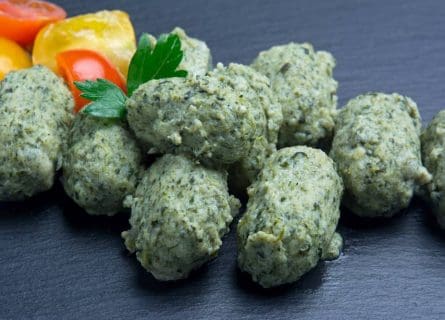
A Taste of Maremma: Discovering Authentic Tuscan Cuisine
November 19, 2023
Uncover the flavors of Maremma: A guide to Tuscan culinary delights. Explore traditional dishes, local ingredients, and historic food influences.
By: Simona Piccinelli / Last updated: April 8, 2024
Estimated reading time: 14 minutes
Just the thought of pasta makes the mouth water! With so many sizes, varieties, and sauces, it is a monumental task to select only 10. However, these selections are not only staples of Italian cuisine but are also revered as some of the best pasta dishes worldwide.
Contrary to the popular myth that Marco Polo introduced pasta to Italy from China, pasta was already mentioned in a document from 1250 AD, predating Polo’s return by forty-five years. The dry variety of pasta as we know it today originated in the Middle East and was imported into Sicily during the Arab invasions. There are references to pasta in Muslim texts as far back as 1,000 AD. On the other hand, Greece has been linked to fresh pasta, which was probably similarly imported into Italy. One of the most popular dry pasta is from Gragnano near Naples. During the 1500s, people considered this town the home of durum wheat pasta, and in the 1750s, the city’s administration reorganized the urban layout to benefit maccheroni drying!
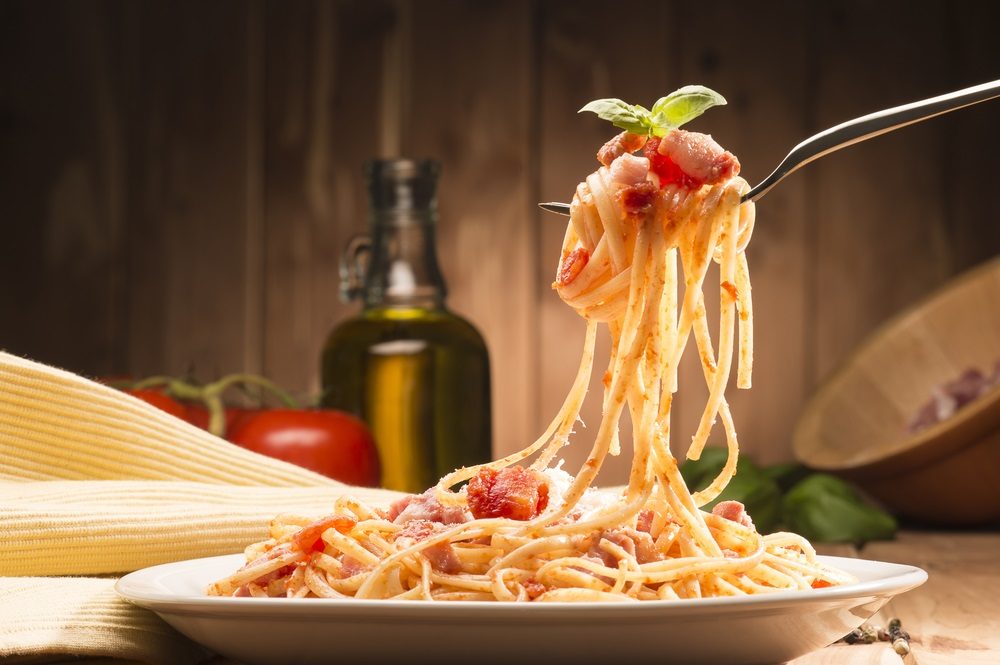
So what is the difference between dry pasta “pasta secca” and fresh pasta “pasta all’uovo”? Well, the ingredients for a start. Southern Italy produces most dry pasta, which usually does not contain eggs since they would perish quickly in such a hot climate. Its essential ingredients, ground semolina flour, and water, are mixed into a paste and pushed through molds of different shapes. The pasta is then left to dry at low temperatures over a few days until all the moisture evaporates.
Fresh pasta, traditionally more common in the north and central regions, can be made with different flour types, although the most common is the “00” high-gluten flour. The mixture includes eggs to create a more malleable, bread-like dough that suits more delicate sauces.
One is not better than the other, although locals loyal to their regional variety might disagree; it depends on the sauces you will use or the textures you want to experience. So, let’s explore some of the most popular pasta dishes and their development.
Pasta Alla Norma is a typical dish from the Sicilian city of Catania incorporating traditional Mediterranean produce, namely eggplant/aubergine. The name was inspired by Nino Martoglio, a Sicilian poet and writer who compared it to Bellini’s masterpiece “Norma” upon tasting the sumptuous dish for the first time.
As with most Italian pasta greats, there are very few ingredients; however, what makes every Italian pasta dish so tasty is the quality of the product and the marriage with the right variety of pasta, resulting in taste bud-tingling flavors. You will need eggplant, ripe flavorsome tomatoes, salted ricotta, garlic, basil, olive oil, salt, and pepper for this recipe. Add salt to the eggplant and allow it to “drain” before cooking to release some of the bitter juices. Cheap, tasty, easy to make, and perfect for vegetarians, this delicious but simple dish is a crowd-pleaser every time.
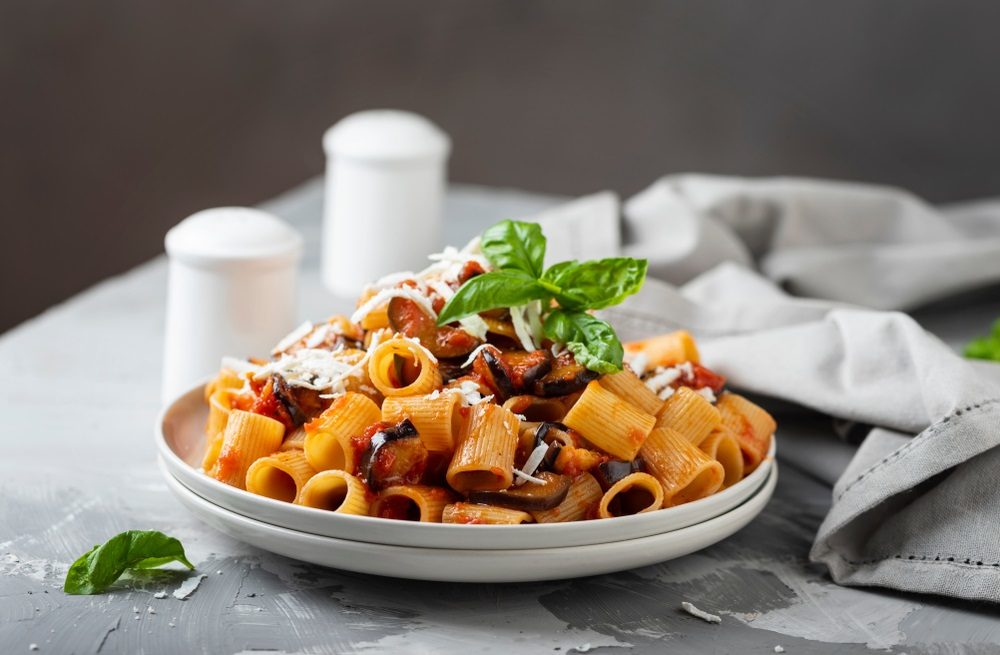
This most famous Roman dish was named after originating in the town of Amatrice in the Lazio region. The original recipe, Gricia (still prepared in central Italy), was not tomato-based as tomatoes had not been introduced into Italy at that stage. As we know it today, the recipe became very popular in Rome during the 19th century as economic contacts between Rome and Amatrice became stronger.
Ingredients of the classic version vary slightly as the recipes developed depending on the availability of local produce. Guanciale (cheek bacon) and tomatoes are usually used. Although onions have always been included when I have eaten Amatriciana, they do not seem to be favored in the region surrounding Amatrice. Lashings of black pepper or chili pepper and pecorino Romano (from Amatrice if you can get it!) are standard also. The pasta choice is usually spaghetti or bucatini (slightly thicker spaghetti). Fresh pasta is not advised for this dish.
This peppery pasta will warm you through after an exhausting day of sightseeing in the capital, and to my mind, is the perfect introduction to Roman cuisine.
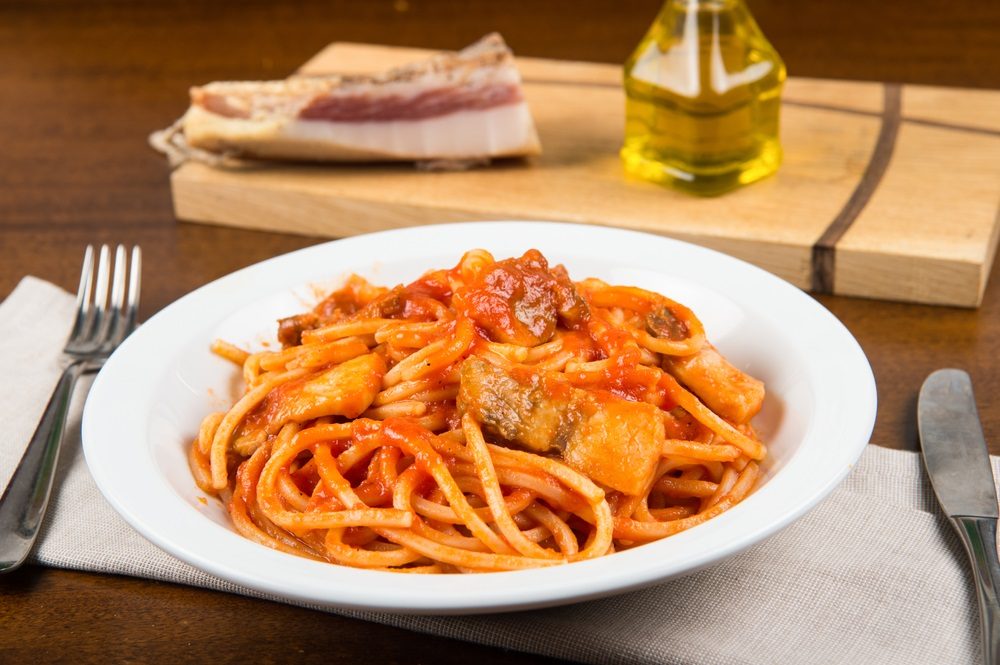
Spaghetti Bolognaise is probably the most popular pasta dish outside Italy. However, in Bologna, Ragù Alla Bolognese is always served with egg tagliatelle, which is better for holding the heavy meat sauce. Dating back to at least the 1400s, Bolognaise was originally tomato-less and, even today, should taste more of meat than tomato sauce. There have been so many variations on this beloved dish that in 1982, the Bolognese delegation of Accademia Italiana della Cucina deemed it necessary to issue the “correct” classic Ragù recipe.
Ingredients: 300 g beef (thin beef skirt is preferable), 150g pancetta, 50g celery, 50g carrot, 50g onion (notice no garlic), five spoons of tomato sauce or 20 g triple tomato puree, a Half cup of dry white or red wine, 1 cup (250 mL) whole milk, salt, and pepper to taste (notice no herbs). However, even the Bolognesi will add sausage, rabbit, chicken, or porcini mushrooms to add another dimension. The key to a good Ragù is to simmer it for quite a long time; seven or eight hours of cooking are typical to bring all the flavors together.
Ragù alla Bolognese is also the basis for Lasagna, another well-known and well-loved dish worldwide. In Bologna, cooks usually make it with green lasagne sheets, a pasta that incorporates cooked spinach. Many theories exist about the dish’s origins, although the most likely seems to be that a similar dish existed in ancient Greece and was later transferred to the Romans. The ancient Greek word “Lasagnum” refers to a dish or bowl, hence the name we know today. The beautiful thing about Lasagna is its versatility. As mentioned above, it is delicious with a Ragù but equally tasty with roasted vegetables, wild mushrooms, or cheese sauce for the veggies. Recently, I had the fortune to taste an artichoke version cooked by my Neopolitan friend’s mother, which I have to say has been my favorite so far. I dream of that Lasagna! If you have the opportunity, I highly recommend it.
There are many hypotheses for the origins of this well-loved dish. The simplicity of the ingredients could mean that it was an easy dish for the charcoal makers “Carbonari,” who spent long periods in the woods during the year. However, the fact that we do not see reference to this dish in Italian cookbooks until after the Second World War could demonstrate that Roman trattorias invented it to keep the American troops happy using ingredients (eggs and bacon) standard issue for the US soldiers.
Even culinary experts cannot agree on the origins, so we will probably never know. This is not the only debate attached to this most delicious dish! What type of bacon should be used? Should you use the whole egg or just the yokes? Do you add cream? What cheese do you put on top?
Most chefs agree you must not allow the eggs to overcook, as the consistency should be creamy and not scrambled. Classic ingredients include pancetta or guanciale (cheek), bacon, eggs, black pepper, and cheese (pecorino Romano or parmesan). Onions or garlic are usually used too. Add the spaghetti or rigatoni to the bacon, which has been cooked in a pan. Turn off the heat and mix in the raw egg, allowing the heat to cook the eggs slightly. At the last moment, grind a generous helping of black pepper on top and sprinkle with an abundance of cheese. Simply delicious!
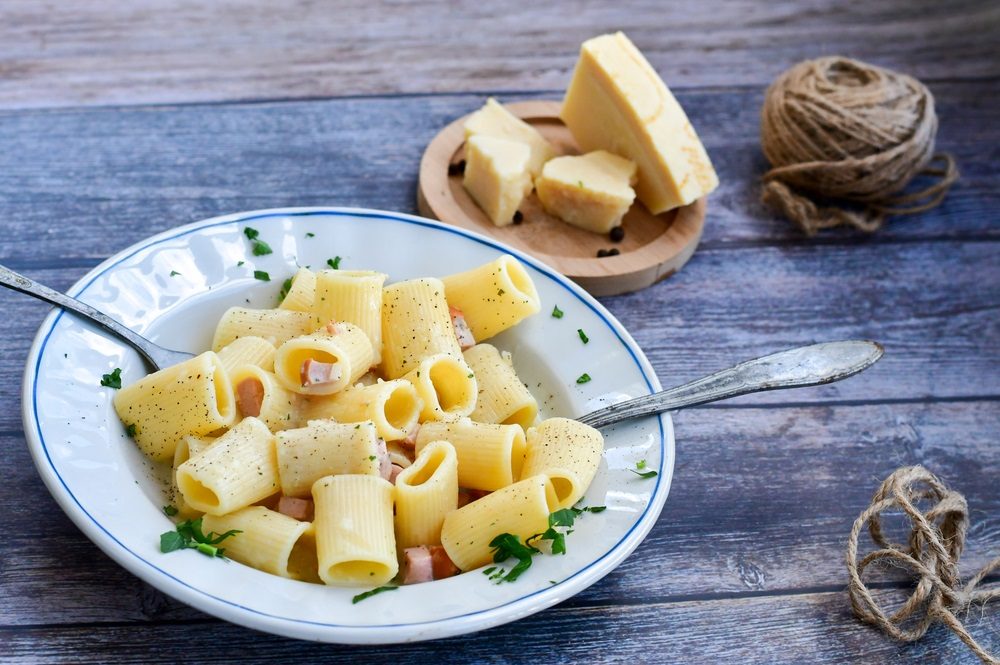
Most Italian pasta sauces are simple and ingenious; however, Ragù Napoletano does not fit this description. This creamy, meaty sauce takes hours to cook, and many Neopolitan women cook it overnight, getting up regularly to stir it if they want to achieve the desired result. The sauce’s meat is pig ribs/roast, guanciale, prosciutto, and bacon (in large chunks). The recipe also includes triple tomato concentrate, red wine, onions, garlic, parsley, salt, and pepper. It would take more than one paragraph to explain the complete recipe (and probably to some degree!). However, it is essential to brown the meat nicely, cook it ultra-slowly, and add the tomato concentrate a little at a time to achieve a creamy burgundy red sauce.
Pasta types could be Paccheri (shorter rigatoni tubes) or Strozzapreti, a twisted kind of gnocchi whose name literally translates as “Priest-stranglers” after a greedy 18th-century priest almost choked to death on them! Top the final dish with cheese like a mature Caciocavallo Sorrentino to cope with the rich depth of flavor.
The main differences between this Ragù and the Bolognese version lie in the type of meat used, the size of the chunks, and the type of pasta. Moreover, the Neapolitan recipe does not include milk and uses more tomatoes than its northern cousin. Finally, cooks often use the pieces of stewed meat from the Neapolitan Ragù as a main course to follow the pasta starter. Two dishes for the price of one (with a lot more work than two dishes involved!). A lot of sweat and dedication are needed, but the result is well worth it! Better still, go to Naples and have one of the experts make it for you!
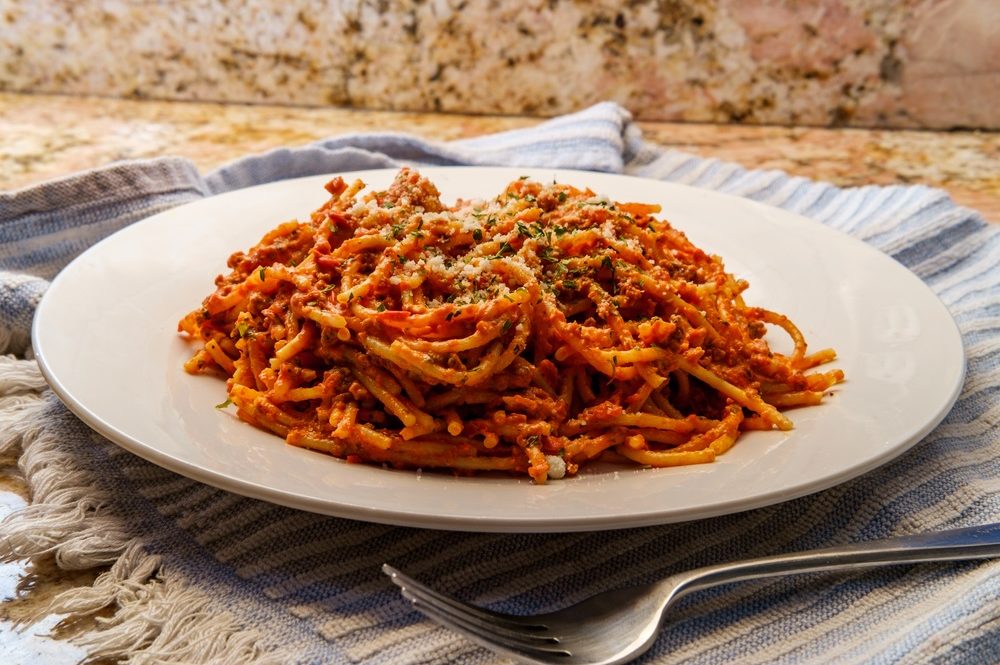
Orecchiette (little ears) is a homemade pasta commonly found in Puglia, Southern Italy. The name indicates the pasta’s shape: small, domed, white disks with one smooth side and one rough side to hold the sauce. Unlike other fresh pasta, its preparation usually does not include eggs. If you drive through Puglia during springtime, it is not uncommon to see young and old women sitting outside around tables, diligently pressing each piece of dough into an Orecchiette with their right thumbs and gossiping about the latest happenings in the neighborhood.
This pasta probably originated in Provence, where a similar pasta was made and then introduced into southern Italy by the Anjous, a French dynasty that dominated Puglia during the 1200s. Nowadays, chefs typically make the sauce to accompany these delicious “little ears” with “Cime di Rapa,” a bitter leafy green known as Rapini in English. If you can’t find Rapini, broccoli is a good substitute. Ingredients are rapini (or broccoli), garlic, anchovies, olive oil, Pecorino, and toasted breadcrumbs.
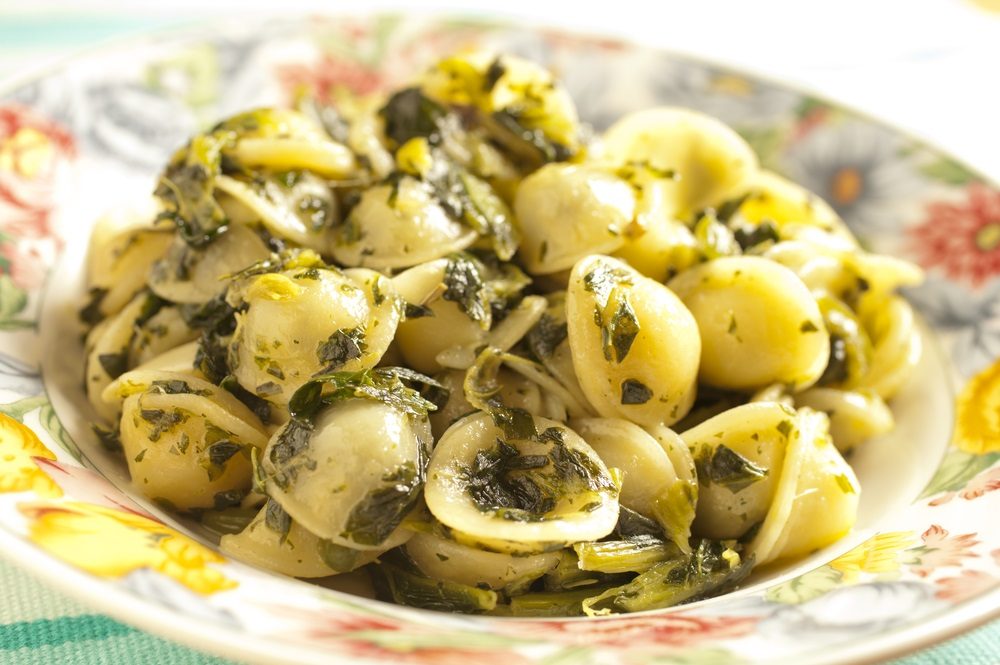
There are many types of pesto in Italy, depending on the region you visit and the produce available locally. However, we all know and love the pesto alla Genovese (from Genoa). The prime ingredient for this type of pesto is basil, which seems to grow very favorably in the Ligurian climate. The name originates from the verb Pestare, which means to grind (as in pestle and mortar).
As with most pasta sauces in Italy, variations on the same theme differ from family to family. The most common classic recipe is now basil, pine nuts, olive oil, garlic, and cheese (Parmigiano Reggiano). Some recipes include other types of nuts. Two types of pasta are associated with Pesto Alla Genovese: fresh Trofie, a twisted kind of gnocchi made with white flour, and Trenette, which is slightly thinner than Linguine. Nowadays, it is pretty common to add potatoes and French beans to the recipe, especially when using Trenette, which I have to say I find particularly delicious!
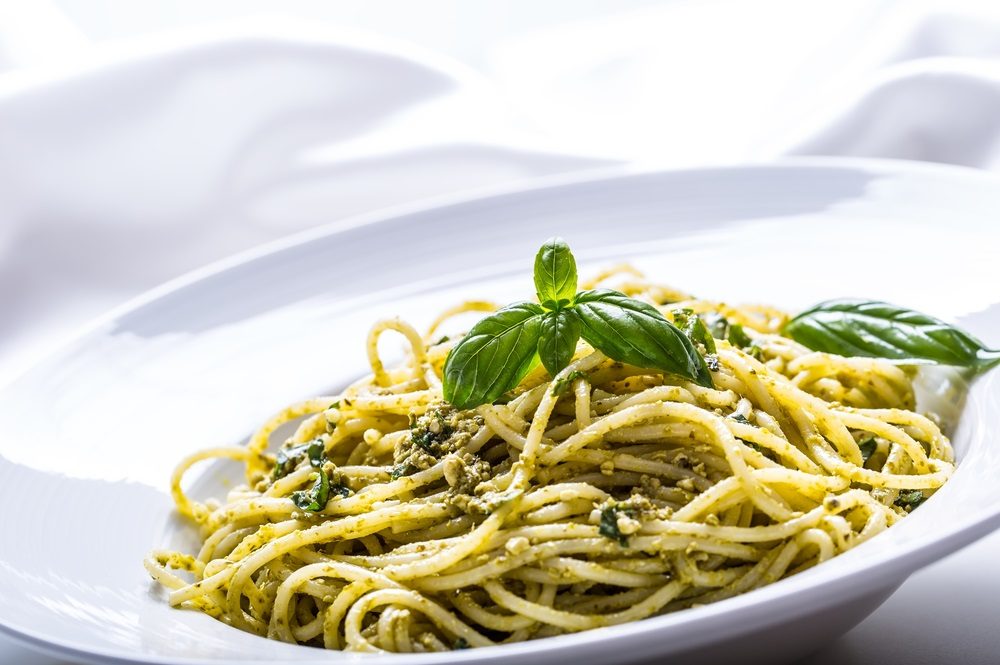
Due to the name Puttanesca, many believe this sauce has some connection to prostitutes, as “Puttana” means just that in Italian. However, the name came about one evening in the early 1950s on the island of Ischia in the Gulf of Naples. Architect Sandro Petti was entertaining a group of friends when they asked him to rustle up something to eat as they were starving. However, he told them he didn’t have much left in the kitchen, and they would have to go somewhere else to get something to eat. It was very late in the evening, and it was almost impossible to find anywhere open then. One of his friends exclaimed, ‘Don’t worry, Sandro, just make us a “puttanata qualsiasi,” which roughly translated means a slightly more vulgar version of “any old thing.”
Sandro duly threw together a sauce consisting of the minimal ingredients in his larder, i.e., a few tomatoes, olives, capers, garlic, olive oil, and some oregano. The recipe today usually includes some anchovies, chili, and parsley.
After the dish’s success that evening, Petti added it to the list of starters on his menu, calling it Puttanesca as Puttanata seemed a bit vulgar. The key to this dish is to make a basic Marinara sauce and then add the other ingredients. The tomato should only color but not dominate the sauce, allowing all the different flavors to come through. As is true for Italian cuisine in general, less is more.
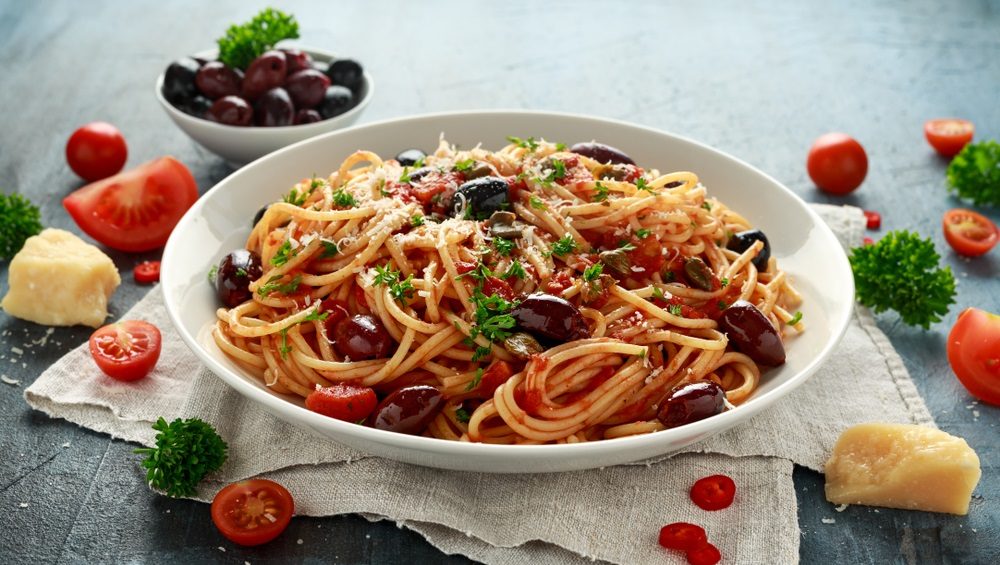
Merchants in Venice and Tuscany are credited with the earliest mentions of ravioli as far back as the 14th century. Ravioli was even known to the 14th-century English population, appearing in an Anglo-Norman vellum manuscript.
Many ravioli options (cheese, mushroom, meat) without including their cousins, tortelloni, tortellini, etc. One of my absolute favorites is Ravioli di Ricotta e Spinaci al Burro e Salvia. The key to this dish, in my opinion, is the consistency of the fresh pasta, neither too firm nor too sloppy, and a generous amount of Parmigiano Reggiano heaped on top just before serving.
The ravioli are stuffed with ricotta, spinach, some Parmigiano Reggiano, an egg, salt, and pepper. Simultaneously, melt about 40g of unsalted butter in a pan, taking care not to burn or split it. Add 8-12 sage leaves and allow to infuse for a few minutes on very low heat. The perfect result is if the sage crisps slightly, adding texture to the overall dish. Toss the ravioli in the sauce and grind some black pepper on top. Take off the heat, serve, and spoon on lots of Parmigiano. Delicate, subtle, and mouth-wateringly pleasing!
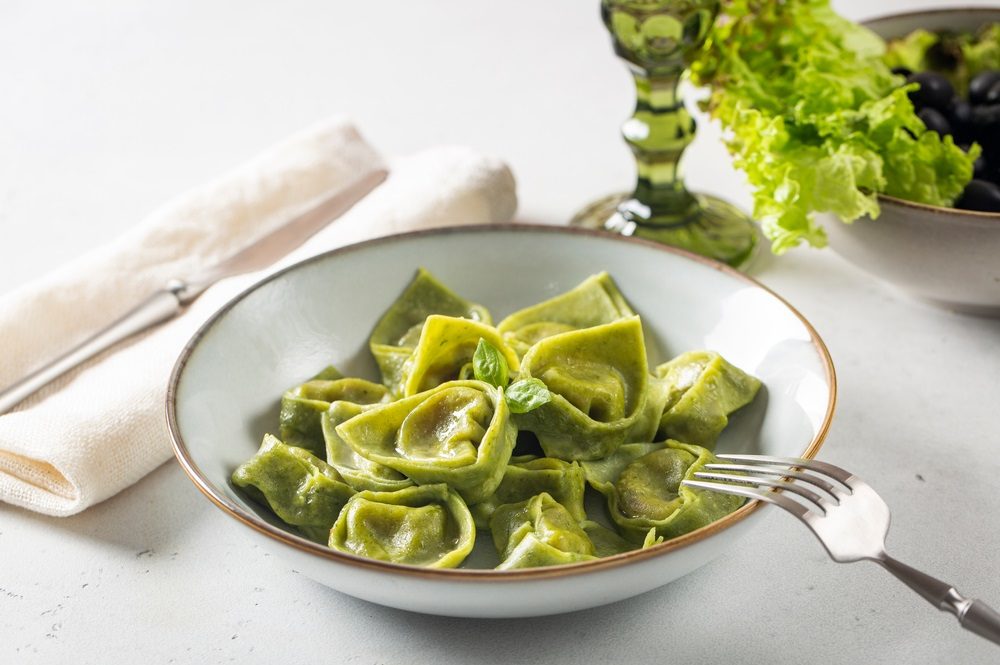
Considered to come from the Abruzzo region, this cheap and cheerful dish is now popular in the length and breadth of the boot. As there are very few ingredients (garlic, olive oil, chili, parsley, and spaghetti), it is usually the first dish young Italians learn to make. Also, if you end up back at an Italian friend’s house after a night on the beer, “facciamo due spaghetti” is the dish they will most often offer you!
To make the sauce, sauté minced or pressed garlic in olive oil (about 5 tbsp) on low heat to avoid burning. Add dry or fresh chili to give it a good kick. Once the oil has absorbed all the flavors, add the cooked spaghetti to the pan and toss well. Mix in chopped flat-leaf parsley, serve, and grate Pecorino or parmesan cheese over the top or some toasted breadcrumbs, common in the southern regions. Simply scrumptious!
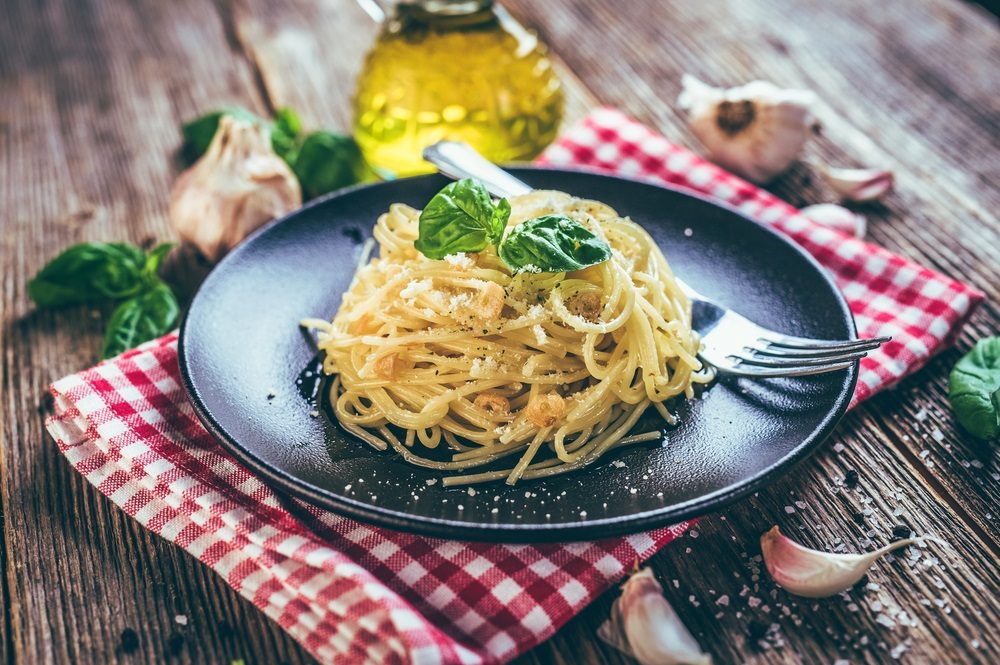
If you would like us to customize an exclusive luxury tour, contact us and let us know your travel plans. We offer luxury food and wine tours for private groups of a mininium two guests. In addition, all of our private, chauffeured tours are available year-round upon request.


Alice Carrollsays:
May 29, 2020 at 3:19 am
Wow, it's interesting to know that Puttanesca has its origins from a scarcity of ingredients but managed to become one of the well-known pasta dishes of Italy. A friend of mine who is currently in an exchange student program in Italy told me that Puttanesca is one of the best pasta dishes she has ever had. Perhaps one of these days, I'm going on a food trip to different Italian restaurants to hopefully experience when she has tasted.
Des Mc Carthysays:
April 21, 2018 at 9:47 am
Thank Andi - I have updated the blog post. All the best
Andi Peterssays:
April 11, 2018 at 8:07 pm
Haven't read whole article, but @ beginning... "...it’s basic ingredients are ground semolina flour and water ..." Should be "its". Kind regards.
Foodetcsays:
August 27, 2017 at 10:44 pm
Great read! I love all pastas mentioned above. Carbonara might be my number one though. :)
owynjohnnysays:
June 9, 2014 at 11:09 am
Hi Guys, I love pasta and I can't get enough of it but now and then I like to add something new, I bought some truffle oil from here http://www.trufflehunter.co.uk/truffles/buy-truffles.php?c=Truffle-Oil and I was wondering if these recipes will work well with this type of oil?
Jennifer Connersays:
February 2, 2012 at 9:49 pm
Oh, my mouth is watering. I love pesto and Spaghetti/Rigatoni alla Carbonara.
Jessica | Oh Cakesays:
January 4, 2012 at 10:12 pm
Oooh such delicious photos! This makes me miss Italy. My personal favorites are lasagna bolognese, pappardelle al ragu, pesto, pumpkin ravioli, and aglio e olio.
Fabiosays:
January 4, 2012 at 11:29 am
my personal choices: carbonara, amatriciana, pesto, aglio e olio, cacio e pepe!